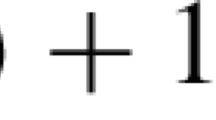Summary
The famous Ginzburg-Landau equation describes nonlinear amplitude modulations of a wave perturbation of a basic pattern when a control parameterR lies in the unstable regionO(ε 2) away from the critical valueR c for which the system loses stability. Hereε>0 is a small parameter. G-L's equation is found for a general class of nonlinear evolution problems including several classical problems from hydrodynamics and other fields of physics and chemistry. Up to now, the rigorous derivation of G-L's equation for general situations is not yet completed. This was only demonstrated for special types of solutions (steady, time periodic) or for special problems (the Swift-Hohenberg equation). Here a mathematically rigorous proof of the validity of G-L's equation is given for a general situation of one space variable and a quadratic nonlinearity. Validity is meant in the following sense. For each given initial condition in a suitable Banach space there exists a unique bounded solution of the initial value problem for G-L's equation on a finite interval of theO(1/ε2)-long time scale intrinsic to the modulation. For such a finite time interval of the intrinsic modulation time scale on which the initial value problem for G-L's equation has a bounded solution, the initial value problem for the original evolution equation with corresponding initial conditions, has a unique solutionO(ε2) — close to the approximation induced by the solution of G-L's equation. This property guarantees that, for rather general initial conditions on the intrinsic modulation time scale, the behavior of solutions of G-L's equation is really inherited from solutions of the original problem, and the other way around: to a solution of G-L's equation corresponds a nearby exact solution with a relatively small error.
Similar content being viewed by others
References
P. Chossat, G. Iooss: Primary and secondary bifurcation in the Couette-Taylor problem,Japan J. Appl. Math. 2 (1985)
H. Swinney, J. P. Gollub (eds): Hydrodynamic Instabilities and the Transition to Turbulence,Topics in Applied Physics 45, Springer-Verlag (1981)
K. Stewartson, J. T. Stuart: A nonlinear instability theory for a wave system in plane Poiseuille flow,J. Fluid Mech. 48 (1971)
C. A. Holmes: Bounded solutions of the nonlinear parabolic amplitude equation for plane Poiseuille flow,Proc. R. Soc. Lond. A. 402 (1985)
P. G. Drazin, W. H. Reid:Hydrodynamic Stability, Cambridge University Press (1981)
M. van Dycke:An album of fluid motion, The Parabolic Press (1982)
Y. Kuramoto:Chemical Oscillations, Waves and Turbulence, Springer-Verlag (1984)
H. Haken (ed.): Evolution of order and chaos,Springer series in Synergetics 17, Springer-Verlag (1982)
J. W. Wesfreid, S. Zaleski (eds.): Cellular structures in instabilities,Lecture Notes in Physics 210, Springer-Verlag (1984)
H. R. Brand, P. S. Lomdahl, A. C. Newell: Benjamin-Feir turbulence in convective binary fluid mixtures,Phys. D. 23 (1986)
W. Eckhaus:Studies in nonlinear stability theory, Springer-Verlag (1965)
W. Eckhaus, G. Iooss: Strong selection or rejection of spatially periodic patterns in degenerate bifurcations,Phys. D. 39 (1989)
Doelman, A.:On the nonlinear evolution of patterns; modulation equations and their solutions, thesis, Un. of Utrecht, 1990
M. J. Landman: Solutions of the Ginzburg-Landau equation of interest in shear flow transition,Stud. Appl. Math. 76 (1987)
A. C. Newell: The dynamics of patterns: a survey, to appear inPropagation in Nonequilibrium Systems (ed. J. E. Westfreid), Springer-Verlag
G. Iooss, A. Mielke, Y. Demay: Theory of steady Ginzburg-Landau equation, in hydrodynamic stability problems,Eur. J. Mech. B/Fluids 8 (1989)
R. C. DiPrima, W. Eckhaus, L. A. Segel: Non-linear wave-number interaction in near-critical two-dimensiona flows,J. Fluid Mech. 49 (1971)
W. Eckhaus: Asymptotic analysis of singular perturbations,Stud. Math. Appl. 9, North-Holland Publishing Company (1979)
P. Holmes: Spatial structure of time-periodic solutions of the Ginzburg-Landau equation,Phys. D. 23 (1986)
J. B. Conway:Functions of one complex variable, Springer-Verlag, Berlin (1973)
L. Hörmander:Linear partial differential operators, Springer-Verlag, Berlin (1963)
E. Kreyszig:Introductory Functional Analysis with Applications, Wiley, New York, 1978.
L. A. Segel: Distant side-walls cause slow amplitude modulation of cellular convection,J. Fluid Mech. 38, 203–224 (1969)
A. Iooss, G. Mielke: Bifurcating time-periodic solution of Navier-Stokes equations in infinite cylinders, to appear inJ. of Nonl. Sc.
J. P. Collet, P. Eckman: The time dependent amplitude equation for the Swift-Hohenberg problem,Comm. Math. Phys.,132 (1990)
A. Newell, J. Whitehead: Finite bandwidth, finite amplitude convection,J. Fluid Mech.,38, 279–303 (1969)
Author information
Authors and Affiliations
Additional information
Communicated by Gérard looss
Rights and permissions
About this article
Cite this article
van Harten, A. On the validity of the Ginzburg-Landau equation. J Nonlinear Sci 1, 397–422 (1991). https://doi.org/10.1007/BF02429847
Received:
Accepted:
Published:
Issue Date:
DOI: https://doi.org/10.1007/BF02429847



